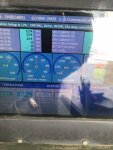Tommytone
Member
- 56
- 44
- 18
- Location
- Ashland, ohio
Thank you! IAs was mentioned earlier in this thread by “Guyfang” I believe, a notable difference in temperature on the exhaust manifold ports by using your hand would indicate a problem cylinder. A difference in manifold port temperature as measured with an infrared gun may just be incidental. Have you allowed this engine to reach operating temperature yet? If not, I would do so. That is unless the engine oil pressure is low. (We still don’t know what that is yet?) The reason for allowing the engine to operate up to normal operating temperature is because many times these cold engine misses will clear up. Especially on an engine that hasn’t seen any hours on it for a while. Once the engine has reached normal operating temperature, if it still has a miss, or if you can still feel/see a big difference in exhaust manifold port temperatures, now you can begin the trouble-shooting process on that. With the engine running (again, as Guy has previously mentioned) simply crack open the high pressure line at the injector for cylinder #1. (It’s like removing the spark plug wire from cylinder #1 on a gas pot engine) If there is a change in the sound of the engine with that line cracked open, close it and move on down to cylinder #2 and so forth and so on. When you crack an injector line loose (on an engine that’s up to operating temperature) and the engine sound does not change, that’s where your problem is. Now you get to find out if it’s an injector problem, a valve problem, a problem with piston and/or rings etc. My suspicion is that this engine will clear itself up when you allow it to run up to full operating temperature. (For clarification, that would be at least 180 degrees on the temperature gauge, or until the temperature gauge doesn’t go up any further) Report back, good luck and have fun too! Oh, BTW…please, please wear eye protection when cracking open those high pressure lines on a running engine!!!
Thank You! I ram it today and it seems to run fine after a few minutes and the white smoke clears etc. the oil pressure is about 65 pounds then, after a little longer went up into the 70s (73 psi). Next I need to load it down some and get a good test in that way. When it starts the voltage is over 220 on the main screen and I bring it down to around 215. The individual lines are a little high say around 124 if memory serves. I am not worried it just seemed to me that it would be half of 215 or107 but…. Anyhow I will move on to load testing unless there is something else I should do first. My thought was to do a load test get it running at temp then change the oil as it looks new. If this is a bad plan I can change it first.As was mentioned earlier in this thread by “Guyfang” I believe, a notable difference in temperature on the exhaust manifold ports by using your hand would indicate a problem cylinder. A difference in manifold port temperature as measured with an infrared gun may just be incidental. Have you allowed this engine to reach operating temperature yet? If not, I would do so. That is unless the engine oil pressure is low. (We still don’t know what that is yet?) The reason for allowing the engine to operate up to normal operating temperature is because many times these cold engine misses will clear up. Especially on an engine that hasn’t seen any hours on it for a while. Once the engine has reached normal operating temperature, if it still has a miss, or if you can still feel/see a big difference in exhaust manifold port temperatures, now you can begin the trouble-shooting process on that. With the engine running (again, as Guy has previously mentioned) simply crack open the high pressure line at the injector for cylinder #1. (It’s like removing the spark plug wire from cylinder #1 on a gas pot engine) If there is a change in the sound of the engine with that line cracked open, close it and move on down to cylinder #2 and so forth and so on. When you crack an injector line loose (on an engine that’s up to operating temperature) and the engine sound does not change, that’s where your problem is. Now you get to find out if it’s an injector problem, a valve problem, a problem with piston and/or rings etc. My suspicion is that this engine will clear itself up when you allow it to run up to full operating temperature. (For clarification, that would be at least 180 degrees on the temperature gauge, or until the temperature gauge doesn’t go up any further) Report back, good luck and have fun too! Oh, BTW…please, please wear eye protection when cracking open those high pressure lines on a running engine!!!
Attachments
-
74.9 KB Views: 2
Last edited:



